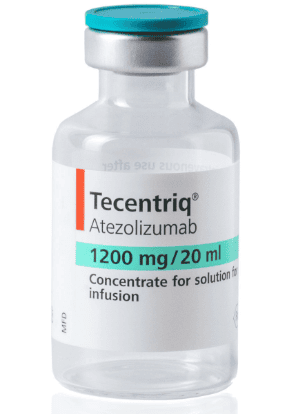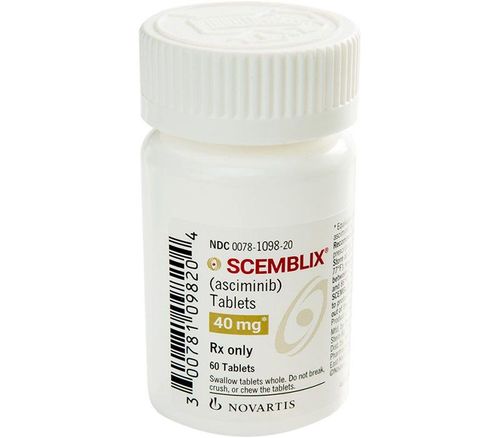This is an automatically translated article.
Xospata drug is a drug made in the form of oral tablets, the drug is used strictly according to the doctor's prescription. Xospata is recognized by the FDA as a special drug for rare diseases and was approved by this agency for treatment in November 2018.
1. What effects does Xospata have?
Xospata drug has the active ingredient Gilteritinib. Xospata's mechanism of action is understood as follows: Kinase is an enzyme that promotes cell growth, in the human body there are many different kinases that help control different stages of cell development. By blocking a specific enzyme kinase, Xospata can slow the growth of cancer cells. Gilteritinib is indicated for use in certain leukemias with mutations in the FLT3 gene. Oncologists will check the patient for mutations in the FLT3 gene before prescribing Xospata. Xospata is used as monotherapy for the treatment of recurrent acute myeloid leukemia (AML) in adults with the FLT3 mutation.
2. How to use Xospata
Xospata medicine is made in the form of tablets, taken orally, usually 1 time per day. Patients should take Xospata tablets with a full glass of water, which can be taken without regard to food. Do not crush, break, or chew Xospata tablets. The dose of Xospata should be taken at the same time each day. If the patient misses a dose of Xospata and it has been more than 12 hours since the usual Xospata dose, take it as soon as you remember. If it has been more than 12 hours, skip the dose of Xospata, do not take 2 doses at once to make up for the missed dose.
Xospata blood levels can be affected by certain foods and drugs, so it's important to avoid taking Xospata with: Carbamazepine, Dexamethasone, Phenytoin, Rifampin, Phenobarbital and St.John's Wort...
3. How to preserve Xospata?
Store Xospata in its original, labeled packaging, at room temperature and in a dry place, do not store Xospata in the medicine box, keep it out of the reach of children and pets.
If caregivers are preparing a dose of Xospata for a patient, they should consider wearing gloves or pouring Xospata directly from the container into the lid, cup, or directly into the patient's hand, avoiding touching the tablet. Always wash your hands before and after administering Xospata to a patient. Pregnant or nursing women should not prepare Xospata for sick people. Do not flush Xospata down the toilet or throw it in the trash.
4. Possible side effects of Xospata
Patients can apply a number of different measures to control the side effects of Gilteritinib for each specific patient. The following are some of the most common or important Xospata side effects:
4.1. Gilteritinib differentiation syndrome causes changes to blood cell production in patients with leukemia. Symptoms of Differentiation Syndrome include fever (temperature >38°C), sudden weight gain, bone or joint pain, and fluid buildup around the heart, lungs, and/or chest, making it difficult to breathe. This syndrome is treated with high doses of steroids (such as dexamethasone or prednisone) and diuretics. Your doctor will watch for these signs or symptoms, but it's important that you tell your doctor or nurse right away if you experience any of these symptoms.
4.2. Muscle or joint pain, headaches Your doctor can recommend medications and methods to help relieve pain.
4.3. Hepatotoxicity The use of Xospata can cause hepatotoxicity, so the treating physician can monitor it through regular liver function tests. Please inform your doctor if you have symptoms of liver toxicity while taking Xospata such as jaundice, yellow eyes, dark urine, right upper quadrant abdominal pain...
4.4. Fever Fever can be a side effect of Xospata , so contact a doctor when the patient's temperature is 38°C or higher.
4.5. Lung problems Xospata can cause many types of pneumonia and/or interstitial lung disease with symptoms including: cough, shortness of breath, and fatigue.
4.6. Peripheral edema Peripheral edema is swelling of the extremities due to fluid retention: swelling of the hands, arms, legs, ankles and feet. The swollen site can become uncomfortable.
4.7. Diarrhea Your doctor may prescribe some medications to control diarrhea caused by Xospata . In addition, patients can apply some measures such as:
Limit high-fiber foods, eat bland foods such as white rice, boiled chicken; Avoid using fresh fruits, raw vegetables, whole grain breads, cereals and nuts while having diarrhea; Use foods high in soluble fiber such as apple sauce, ripe bananas, boiled potatoes, chips, products made with white flour or oatmeal; Drink enough water and limit alcohol or caffeine to prevent dehydration. 4.8. Constipation Patients can prevent or reduce constipation caused by Xospata by the following:
Fiber supplements; Drink 8-10 glasses of water per day; Maintain operations; Use a stool softener 1 or 2 times a day to prevent constipation; If the patient does not have a bowel movement for 2-3 days, they should contact their doctor for suggestions on how to relieve constipation. 4.9. Vomiting During treatment with Xospata, it is possible to use additional drugs to help control nausea and vomiting and change the diet, avoiding foods that can aggravate vomiting symptoms such as: food too thick, greasy/fatty, spicy or acidic (lemon, tomato, orange).
4.10. Mouth ulcers Some cancer treatments can cause ulcers or pain in a patient's mouth or throat. Notify your doctor if your mouth, tongue, inside of your cheeks or throat become white, sore, or painful. Taking regular oral care measures helps prevent or control mouth sores, which in some cases may suggest pain medication.
Brush your teeth with a soft-bristled toothbrush twice a day. Avoid mouthwashes that contain alcohol; Gargle with baking soda and/or table salt with warm water (2 teaspoons baking soda or 1 teaspoon salt in a cup of warm water) 4 times daily; If the patient's mouth is still dry, eat moist foods, drink plenty of water (6-8 glasses) and suck on sugar-free hard candies; Avoid smoking, drinking alcoholic beverages, citrus juices. 4.11. Low blood pressure Xospata medicine can cause low blood pressure, patients should have their blood pressure checked regularly during Xospata treatment and report to their doctor any headaches, vision changes or dizziness. which happens.
4.12. Fatigue Fatigue is a very common feeling during cancer treatment with Xospata , Xospata users often feel exhausted and not relieved by rest. Therefore, during cancer treatment with Xospata and for some time afterward, patients need to adjust their schedule to control fatigue. Besides, reasonable exercise can also help patients fight fatigue caused by Xospata.
4.13. Less common but important side effects Posterior Reversible Circulatory Disorder (PRES): In rare cases, Xospata medicine can cause a neurological disorder known as schizophrenic syndrome. reversible posterior cerebral circulation disorder with symptoms including: headache, convulsions, coma, confusion, blindness, other visual and neurological disorders. QT prolongation: Xospata may cause an abnormal heart rhythm known as QT prolongation, patients should have their heart rhythm checked with an electrocardiogram (ECG) before and during treatment with Xospata. Notify your cancer care team right away if you feel an irregular heartbeat or if you feel dizzy or faint. Pancreatitis: Xospata may cause pancreatitis with severe stomach/abdominal pain with or without nausea and vomiting.
5. How does Xospata affect fertility?
The exposure of the fetus to Xospata drug can lead to birth defects, so patients should not become pregnant or father a child during cancer treatment with Xospata. The use of effective birth control or birth control methods is essential, especially during Xospata treatment and for at least 6 months after Xospata treatment for women and 4 months after when treating men. Even if the menstrual cycle stops or the patient believes that he or she is not producing sperm, the ability to conceive of both sexes still occurs. Note that patients should not breast-feed while taking Xospata and for 2 months after completing treatment. Xospata is a medicine made in the form of an oral tablet, which is used strictly according to the prescription of a doctor to treat a number of rare diseases. To ensure the effectiveness of treatment and avoid unwanted side effects, patients need to strictly follow the instructions of the doctor, professional pharmacist.
Follow Vinmec International General Hospital website to get more health, nutrition and beauty information to protect the health of yourself and your loved ones in your family.
Please dial HOTLINE for more information or register for an appointment HERE. Download MyVinmec app to make appointments faster and to manage your bookings easily.
Reference source: oncolink.org













